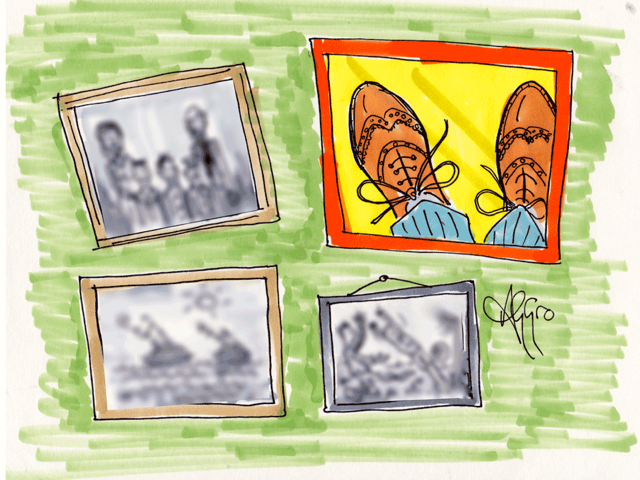20 April 2017
Images From The Past
And feet.
By Chin Chin
Some take photographs of architectural monuments. Some prefer to focus more on human interest with shots of their friends and families. Some use Photoshop to produce modernistic images. I take photographs of feet.

No, no, that isn’t what I mean. Those of you who picture a sinister hooded figure creeping along the beach taking photographs of the bare feet of lovely woman to satisfy his weird cravings have got it all wrong. The feet which I photograph are my own and they are always respectably clad in shoes and socks. Why do it then? Is this the latest Islington fad? A pair of shoes standing as a symbol for something so odd that it cannot bear representation in tangible form. A Foot political dynasty, perhaps? No, it is nothing like that. It is simply that I haven’t quite got the hang of taking pictures with my phone and frequently activate the shutter when I merely wish to admire the contents of the gallery. How do you look at your previous pictures? You hold the phone flat. What happens if you then press the wrong button? You get a picture of your feet, or possibly, if you happen to be sitting down, of your trousers.
It can be a little irritating to take a picture of your shoes, particularly if you accidentally used the video application and never even moved them. After all, it isn’t as though you didn’t already have lots of other photographs, all much the same. Even if you only print off and frame say 1% of your photographic output there are probably a dozen or so pictures of your feet already on your wall. Still, one shouldn’t get too irritated about it. It is one of the few errors one can make in the heavily automated science of photography and it is a reminder of happier days.
The first camera I ever had was a small plastic box-like device with no complicated buttons. It had certainly had a previous owner and I think they must have dropped it. The design worked on the slightly surprising principle that everything on which you wished to focus would be the same distance away so that there was no need to make any adjustments. I don’t know what that distance was originally, but the dropping seemed to have moved the lens so that all images were equally indistinct. However careful the shot, however much you told the chemist to take care in developing the masterwork, the picture was always basically the same: a number of indistinctly fuzzy figures in what appeared to be a thick fog. You could never quite work out who the people were and, all in all, that was something of an advantage.
“Did you get my photograph?” a friend would ask as he came back from scoring the winning goal.
“Oh, yes,” you would reply, “I’ll get it developed this afternoon.” A couple of days later you would proudly produce your standard picture of blurred figures in a fog and say: “This is the one. I’m afraid it is a bit fuzzy but then the camera isn’t really designed for action shots.” Then your aunt asks if you remembered to take a photograph at the family reunion. No need to turn red and admit that you forgot. A copy of the same old photographs will do just fine, especially if she is sensitive about needing glasses. “It’s just like you, Auntie, don’t you think?” Need proof that you went on that field trip? Well it is surprising how like a person a tree can look when seen through a mist. Had I taken a picture of my foot with that camera, I would not have had to go into explanations about not being a foot fetishist. I would simply have said “Can’t you see that it’s a man approaching on a misty day?”.
There came a point, of course, where I became dissatisfied with my broken box camera and went on to something more elaborate. That was a special camera for taking semicircular views. You pressed a button on top and the lens swivelled round. Probably it had been originally used for the taking of school photographs. You remember: the sort where if you ran fast enough round the back you could be in at both ends. The lens moved quite slowly so I expect that it was quite easy.
The trouble was that the camera had to be held very still since otherwise the image on the negative would not be continuous. Once I tried to take a picture of the fleet in Portsmouth Harbour, overlooking, in a twelve year old way, the fact that the small boat I was in was going up and down. When I had the photographs developed the ships were pitching up and down too, with flashes of light all around them. Perhaps I could have sold it as contemporary photograph of the Battle of Jutland taken from the crow’s nest of the flagship. With a touch here and there I’m sure it could have been done, but those were the days before Photoshop and a touch-up in a dark room was beyond my young expertise.
But that’s all gone now. Hold your phone carefully and the picture will be perfectly focussed, the high shutter speed ensuring that there is no smearing. Those who are sufficiently pedestrian are left with only one way of making a mess of it: by pointing the phone the wrong way.
If you enjoyed this article please share it using the buttons above.
Please click here if you would like a weekly email on publication of the ShawSheet

